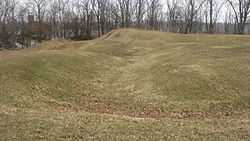Fort Miami (Ohio)
|
Fort Miamis Site | |
 | |
|
Earthworks at the site | |
 | |
| Location | Along the Maumee River in Maumee, Ohio |
|---|---|
| Coordinates | 41°34′21″N 83°37′34″W / 41.57250°N 83.62611°WCoordinates: 41°34′21″N 83°37′34″W / 41.57250°N 83.62611°W |
| Area | 3.7 acres (1.5 ha) |
| Built | 1794 |
| Governing body | Local |
| NRHP Reference # | 75001466[1] |
| Added to NRHP | June 18, 1975 |
Fort Miami was a fort built on the Maumee River at the eastern edge of the present-day city of Maumee, Ohio, and southwest of the present-day city of Toledo, Ohio. It was built by the British on territory disputed between Britain and the USA; the terms of the Treaty of Paris that ended the American Revolutionary War clearly assigned the territory to the United States, but according to the British interpretation of the treaty, the relevant terms and concession of territory had no force unless and until the USA complied with the terms relating, e.g., to compensating Loyalists for their loss of property and permitting their return unmolested, etc. (These and related disputes were superseded by the fully implemented terms of later treaties.) In 1794 the British built Fort Miami (Miamis) to block Gen. Anthony Wayne's advance on Detroit and to encourage the Ohio Indians in their resistance to U.S. penetration north and west of the Ohio River. The fort was a log stockade, which had four bastions, each capable of mounting four cannon, a river battery, barracks, officers' quarters, supply buildings, and various shops. A defensive ditch, 20 to 25 feet deep, ran along the land side of the fort.
Late in 1794 General Wayne and his troops marched northward toward Fort Miami from Fort Greenville. Just south of the fort, ambushed by the Native Americans and a small party of Canadian militia, he ordered a charge and dispersed his adversaries, in the Battle of Fallen Timbers. The Native Americans fled to Fort Miami, but the commander of the fort shut them out. Beaten and disillusioned, the Native Americans dispersed and one year later their tribal elders gathered at Fort Greenville to negotiate with Wayne. The Treaty of Greenville opened most of the present State of Ohio and part of present Indiana to United States settlement. In 1796, under the terms of Jay's Treaty (1794), the British abandoned Fort Miami. Wayne occupied and garrisoned it, but about 1799 U.S. troops abandoned it.
The fort played a role in British support for Native American hostilities against the U.S. In August 1794, Anthony Wayne defeated the Native Americans at the Battle of Fallen Timbers within sight of Fort Miami. Under the terms of Jay's Treaty, the British evacuated frontier posts within U.S. territory. The British again occupied the site during the War of 1812, which at the time was opposite the American Fort Meigs. During the War of 1812 Tecumseh, the Shawnee chief, and British officials maintained headquarters at the fort, from where they moved against Gen. William Henry Harrison at Fort Meigs.
The fort structure no longer stands, and the site reverted to agricultural and, later, public park use. Today it sits as a small enclave in residential development.
In 1942 several Ohio civic and patriotic organizations acquired a part of the site of the old fort. Nothing remained of the original structure except parts of the earthworks. In 1953 the Ohio State Archaeological and Historical Society conducted preliminary excavations, and in 1957 the Historical Society of Northwestern Ohio placed a marker at the site, which remains undeveloped. In 1975, the site of the fort was added to the National Register of Historic Places.[1] It is located at 41°34′21″N 83°37′34″W / 41.57250°N 83.62611°W;[2] a state memorial has been created at the site.[3] Ft. Miami Elementary School of the Maumee Public School System is two blocks away and named after the fort.
References
- ↑ 1.0 1.1 "National Register Information System". National Register of Historic Places. National Park Service. 2009-03-13.
- ↑ U.S. Geological Survey Geographic Names Information System: Fort Miami (Ohio)
- ↑ U.S. Geological Survey Geographic Names Information System: Fort Miamis State Memorial
External links
| Wikimedia Commons has media related to Fort Miamis. |
- Fallen Timbers Battlefield Today, Toledo Metroparks site for the Fallen Timbers Battlefield and Fort Miamis National Historic Site
- Historical Landmarks, information about Fort Miamis from the City of Maumee
- Fallen Timbers Battlefield and Fort Miamis National Historic Site, Survey of Historic Sites and Buildings, Founders and Frontiersmen, National Park Service
- U.S. Geological Survey Geographic Names Information System: Fort Miami (Ohio)
| ||||||||||||||||||||||||||